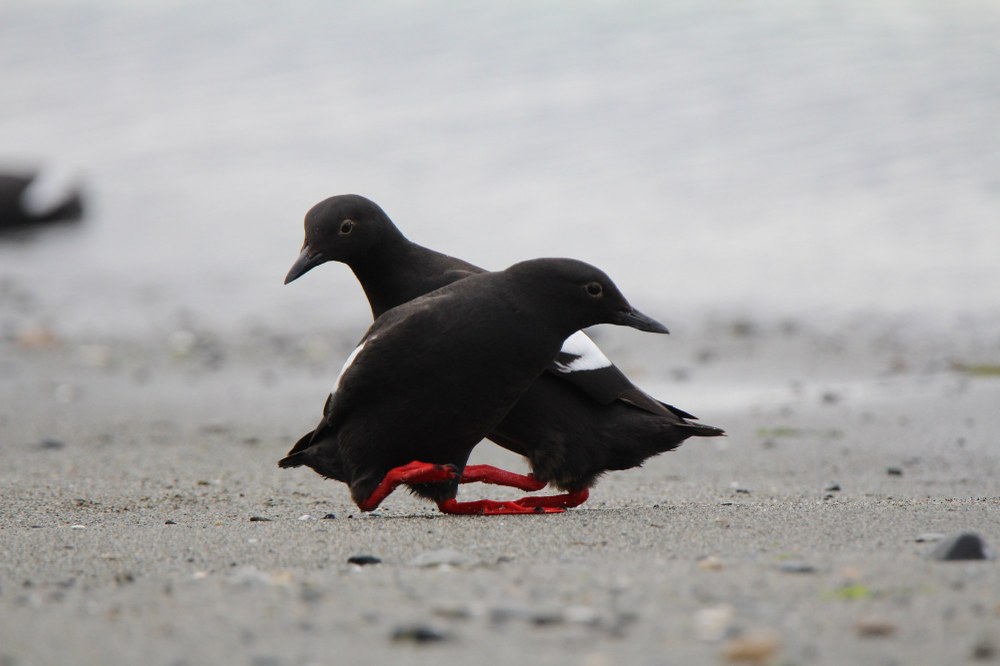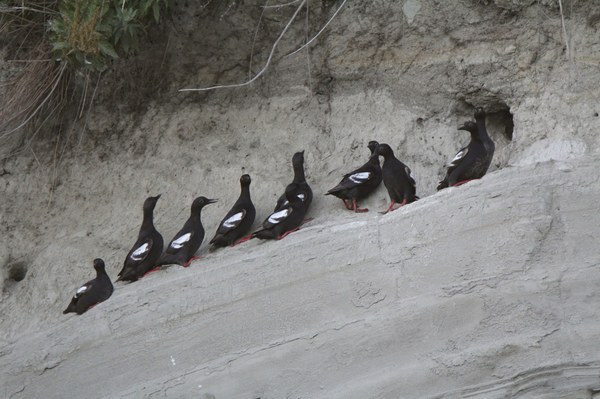
The black bird flew around the dock, showing long, white patches on its wings, and dropped its fire-engine red feet to land on the water with hardly a splash. The pigeon guillemot then looked both directions before diving. Its stubby wings flapped gently under the water as it headed to the shallow bottom in search of food. I caught glimpses of other guillemots coming and going while standing on the dock in Langley on Whidbey Island – some were nesting and may have had nestlings to feed – but the one below me disappeared entirely into the depths.
Pigeon guillemots are related to puffins, in the Alcid family, and they are endemic to the North Pacific. About a quarter million live along the coast from Northern California through Alaska and across into Siberia. They nest in burrows on sea cliffs, in rocky cavities, under piers, and on offshore islands. Guillemots feed almost entirely on benthic (bottom feeding) fish, catching gunnels, sculpins, perch, cod, and sand lance. These birds are an important indicator species for the health of the Puget Sound. They are one of a few seabirds that breed and remain here through winter.
Govinda Rosling is a photographer who volunteers with a citizen-science project around Whidbey Island. Dedicated to the research, education, and protection of the Pigeon Guillemot, this project was started by the Guillemot Research Group. Govinda became involved in 2010, and now helps coordinate annual work and document guillemot behavior through photography. “Each year, we have about 60 volunteers and a paid intern working on our study,” she said.
Guillemots spend the fall and winter offshore, feeding alone or in small groups. In late April and May, they begin to form pair bonds and check out nesting locations. About 1,000 individual birds use the inshore waters around Whidbey each year to nest, and about half those occupy 24 active colonies. Older males come back first and defend the best sites.
“Courtship is amazing to watch,” Govinda said, “A male and female will come together, touch bills, and shuffle around each other, almost like a dance.” They lay their eggs in the back of burrows dug into the cliffs or at the old dock in Langley. Birds will reuse holes from previous years; otherwise, the male must excavate a cavity.
“Our volunteers visit each colony once a week from early June through the end of the breeding season. They record the total number of guillemots in the colony, the number of active burrows, and any evidence of young. Guillemots returning to feed young carry the prey in their bills. This allows our researchers to record the kinds of prey and numbers.” Understanding what kinds of fish each colony depends upon is critical information when approaching conservation initiatives for a healthy marine environment.

“Our volunteers commit a major chunk of time to these birds and, therefore, become incredible spokespeople,” Govinda said. This cadre has raised the awareness of these birds, the importance of managing sea bluffs and offshore waters all through Whidbey Island. Through their outreach, this bird has become a mascot for the island. The bright red feet and black bodies of guillemots make them highly charismatic. The scientific data are given to various state and federal agencies. Long-term studies like this one provide concrete scientific data on how a species is responding to our changing environment.
This article originally appeared in our Winter 2019 issue of Mountaineer Magazine. To view the original article in magazine form and read more stories from our publication, visit our magazine archive.
Add a comment
Log in to add comments.There's a viewable nesting site in the bluffs of Double Bluff State Park on Whidbey Island.
 Thomas Bancroft
Thomas Bancroft